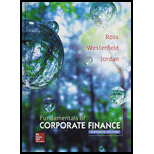
Fundamentals of Corporate Finance with Connect Access Card
11th Edition
ISBN: 9781259418952
Author: Stephen A. Ross Franco Modigliani Professor of Financial Economics Professor, Randolph W Westerfield Robert R. Dockson Deans Chair in Bus. Admin., Bradford D Jordan Professor
Publisher: McGraw-Hill Education
expand_more
expand_more
format_list_bulleted
Textbook Question
Chapter 11, Problem 3QP
Scenario Analysis [LO2] Sloan Transmissions, Inc., has the following estimates for its new gear assembly project: price = $1,700 per unit; variable costs = $480 per unit; fixed costs = $4.1 million; quantity = 95,000 units. Suppose the company believes all of its estimates are accurate only to within ±15 percent. What values should the company use for the four variables given here when it performs its best-case scenario analysis? What about the worst-case scenario?
Expert Solution & Answer
Want to see the full answer?
Check out a sample textbook solution
Students have asked these similar questions
What is the difference between a contra asset account and a liability?i need help.
What is the significance of a company’s price-to-earnings (P/E) ratio? i need answer.
What is the significance of a company’s price-to-earnings (P/E) ratio?
Chapter 11 Solutions
Fundamentals of Corporate Finance with Connect Access Card
Ch. 11.1 - Prob. 11.1ACQCh. 11.1 - What are some potential sources of value in a new...Ch. 11.2 - Prob. 11.2ACQCh. 11.2 - What are the drawbacks to the various types of...Ch. 11.3 - How are fixed costs similar to sunk costs?Ch. 11.3 - What is net income at the accounting break-even...Ch. 11.3 - Why might a financial manager be interested in the...Ch. 11.4 - If a project breaks even on an accounting basis,...Ch. 11.4 - If a project breaks even on a cash basis, what is...Ch. 11.4 - Prob. 11.4CCQ
Ch. 11.5 - What is operating leverage?Ch. 11.5 - How is operating leverage measured?Ch. 11.5 - Prob. 11.5CCQCh. 11.6 - What is capital rationing? What types are there?Ch. 11.6 - Prob. 11.6BCQCh. 11 - Prob. 11.1CTFCh. 11 - Marcos Entertainment expects to sell 84,000...Ch. 11 - Delta Tool has projected sales of 8,500 units at a...Ch. 11 - What is true for a project if that project is...Ch. 11 - A capital-intensive project is one that has a...Ch. 11 - Pavloki, Inc., has three proposed projects with...Ch. 11 - Forecasting Risk [LO1] What is forecasting risk?...Ch. 11 - Sensitivity Analysis and Scenario Analysis [LO1,...Ch. 11 - Prob. 3CRCTCh. 11 - Operating Leverage [LO4] At one time at least,...Ch. 11 - Operating Leverage [LO4] Airlines offer an example...Ch. 11 - Prob. 6CRCTCh. 11 - Prob. 7CRCTCh. 11 - Prob. 8CRCTCh. 11 - Prob. 9CRCTCh. 11 - Scenario Analysis [LO2] You are at work when a...Ch. 11 - Calculating Costs and Break-Even [LO3] Night...Ch. 11 - Prob. 2QPCh. 11 - Scenario Analysis [LO2] Sloan Transmissions, Inc.,...Ch. 11 - Sensitivity Analysis [LO1] For the company in the...Ch. 11 - Sensitivity Analysis and Break-Even [LO1, 3] We...Ch. 11 - Prob. 6QPCh. 11 - Prob. 7QPCh. 11 - Calculating Break-Even [LO3] In each of the...Ch. 11 - Calculating Break-Even [LO3] A project has the...Ch. 11 - Using Break-Even Analysis [LO3] Consider a project...Ch. 11 - Calculating Operating Leverage [LO4] At an output...Ch. 11 - Leverage [LO4] In the previous problem, suppose...Ch. 11 - Operating Cash Flow and Leverage [LO4] A proposed...Ch. 11 - Cash Flow and Leverage [LO4] At an output level of...Ch. 11 - Prob. 15QPCh. 11 - Prob. 16QPCh. 11 - Sensitivity Analysis [LO1] Consider a four-year...Ch. 11 - Operating Leverage [LO4] In the previous problem,...Ch. 11 - Project Analysis [LO1, 2, 3, 4] You are...Ch. 11 - Project Analysis [LO1, 2] McGilla Golf has decided...Ch. 11 - Prob. 21QPCh. 11 - Sensitivity Analysis [LO1] McGilla Golf would like...Ch. 11 - Break-Even Analysis [LO3] Hybrid cars are touted...Ch. 11 - Break-Even Analysis [LO3] In an effort to capture...Ch. 11 - Prob. 25QPCh. 11 - Operating Leverage and Taxes [LO4] Show that if we...Ch. 11 - Scenario Analysis [LO2] Consider a project to...Ch. 11 - Sensitivity Analysis [LO1] In Problem 27, suppose...Ch. 11 - Prob. 29QPCh. 11 - Prob. 30QP
Knowledge Booster
Learn more about
Need a deep-dive on the concept behind this application? Look no further. Learn more about this topic, finance and related others by exploring similar questions and additional content below.Similar questions
arrow_back_ios
SEE MORE QUESTIONS
arrow_forward_ios
Recommended textbooks for you
 EBK CONTEMPORARY FINANCIAL MANAGEMENTFinanceISBN:9781337514835Author:MOYERPublisher:CENGAGE LEARNING - CONSIGNMENT
EBK CONTEMPORARY FINANCIAL MANAGEMENTFinanceISBN:9781337514835Author:MOYERPublisher:CENGAGE LEARNING - CONSIGNMENT Essentials of Business Analytics (MindTap Course ...StatisticsISBN:9781305627734Author:Jeffrey D. Camm, James J. Cochran, Michael J. Fry, Jeffrey W. Ohlmann, David R. AndersonPublisher:Cengage Learning
Essentials of Business Analytics (MindTap Course ...StatisticsISBN:9781305627734Author:Jeffrey D. Camm, James J. Cochran, Michael J. Fry, Jeffrey W. Ohlmann, David R. AndersonPublisher:Cengage Learning

EBK CONTEMPORARY FINANCIAL MANAGEMENT
Finance
ISBN:9781337514835
Author:MOYER
Publisher:CENGAGE LEARNING - CONSIGNMENT

Essentials of Business Analytics (MindTap Course ...
Statistics
ISBN:9781305627734
Author:Jeffrey D. Camm, James J. Cochran, Michael J. Fry, Jeffrey W. Ohlmann, David R. Anderson
Publisher:Cengage Learning
What is Risk Management? | Risk Management process; Author: Educationleaves;https://www.youtube.com/watch?v=IP-E75FGFkU;License: Standard youtube license